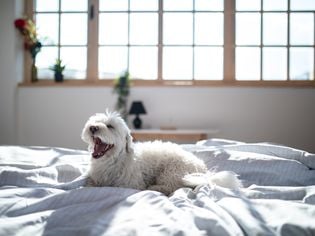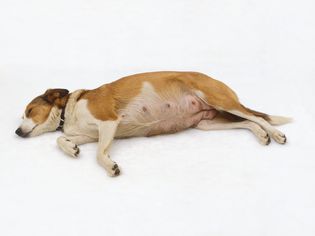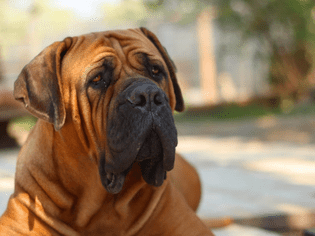The Cockalier is a small to medium hybrid dog breed developed in the United States by breeding a cocker spaniel (American or English) and a Cavalier King Charles spaniel. Depending on their inherited traits, the cockalier’s coat can be medium to long, wavy to curly, and appear in various color combinations and patterns, such as black, brown, red, ruby, or white in bi-color or tri-color. This crossbreed is known for their loving nature, strong loyalty, and long, floppy ears.
Learn more about the care and characteristics of the cockalier.
Breed Overview
GROUP: Hybrid
HEIGHT: 12 to 15.5 inches
WEIGHT: 13 to 30 pounds
COAT: Long, silky; can be curly with feathering around ears, feet, chest, and tail
COAT COLOR: May be tri-color, red and white, ruby, and black and tan or combinations of black, buff, brown, red, silver, and tan with/without roan and merle markings
LIFE SPAN: 10 to 14 years
TEMPERAMENT: Gentle, loyal, companionable, playful, sweet-tempered
HYPOALLERGENIC: No
ORIGIN: United States
Characteristics of the Cockalier
Cockaliers are known and beloved for their sweet and cheerful temperament, devotedness to their family, and love for playtime.
“The spaniels just love family life, whether it is in a small apartment, house, farm—anywhere as long as they are part of the family,” says Jacki Fox, co-owner of Charmed Onz Cavaliers. She considers cockaliers to be adaptable and suitable for just about any environment. They also tend to get along well with children and other pets, especially when socialized early on.
Both cocker spaniels and Cavalier King Charles spaniels generally form strong bonds with their families and enjoy the company of their human families and others, Erin Askeland, MSc, CPDT-KA, CBCC-KA at Camp Bow Wow says. Both breeds are described as eager to please, making them responsive to training. Cockaliers may be more sensitive, meaning they’re highly tuned into their environment and people and may react more strongly than others, Askeland notes.
| Affection Level | High |
| Friendliness | High |
| Kid-Friendly | High |
| Pet-Friendly | High |
| Exercise Needs | High |
| Playfulness | Medium |
| Energy Level | Medium |
| Trainability | High |
| Intelligence | High |
| Tendency to Bark | Medium |
| Amount of Shedding | Medium |
History of the Cockalier
Though the histories of the cocker spaniel and Cavalier King Charles spaniel are well-documented, the cockalier’s exact origins are unknown.
As with most hybrid dogs, it’s believed that the two parent breeds were crossbred within the past few decades due to the skyrocketing popularity of “designer” dogs.
The American Kennel Club (AKC) does not recognize the cockalier as an official mixed breed.
Cockalier Care
As a cross between two spaniel breeds, the cockalier is a naturally energetic and smart dog that requires daily exercise and mental stimulation to be happy and healthy. Their grooming needs will vary depending on their coat type.
Exercise
Cockaliers need about an hour of moderate exercise daily. Fox recommends taking your canine companion for a good walk 2–3 times a day if possible. You can also let them run in the backyard (as long as it’s fenced in due to their prey drive). While cockaliers aren’t particularly fond of rain, Fox says they absolutely love to play in snow.
A few great ways to exercise with your cockalier include:
- Walking (on-leash)
- Playing fetch
- Swimming
- Playing tug-of-war
Cockaliers enjoy enrichment in the form of:
- Being with their human family on outings.
- Playing with food puzzles, snuffle mats, or interactive toys.
- Obedience training or agility training sessions.
Grooming
How often a cockalier needs to be groomed depends on which parent breed’s coat they inherit. For example, the cocker spaniel requires regular grooming and sheds a fair amount, even more so when the seasons change. In contrast, a Cavalier may not need to be groomed as often with the exception of hair trims.
Fox recommends introducing grooming, especially brushing, early on to get your cockalier familiar with the process and help manage shedding and preventing mats and tangles. She trims her cockalier’s nails every few weeks and trims the hair down on the pads of their feet. It’s also important to check and clean their floppy ears regularly and brush their teeth—ideally daily.
Training
“Typically intelligent, affectionate, and eager to please, cockaliers are often straightforward to train,” Askeland says. “Their friendliness makes them wonderful companions, though they may inherit their sensitivity.”
She adds that both Cocker spaniels and Cavalier King Charles spaniels respond best to positive reinforcement. Keeping this in mind, it’s recommended to reward your cockalier with treats, praise, and play for good behavior to encourage learning. Additionally, gentle training should be used due to the sensitive nature of their parent breeds—not only to produce the best results, but to also help maintain the trust and bond with your cockalier, Askeland says.
“Consistency is key in training any dog,” she says. “This is particularly true for cockaliers, who thrive on routine and clear expectations. Be patient and consistent with your cues and rewards to help their understanding.”
It's best to begin training your cockalier as soon as they come home, which will be around 8–14 weeks old. Training at this age range will help them learn how to function in their new environment and can prevent the development of undesirable behaviors, Askeland says. As with all dogs, early socialization is essential to help your cockalier grow into a well-rounded, confident adult.
“Remember, every dog is an individual and there are many aspects that impact behavior including genetics, early socialization, and their ongoing socialization and experiences in the world,” she says. “While certain breeds may be prone to particular behaviors and dispositions, these are general guidelines and not the rule for that breed.”
Common Health Problems
Like all dog breeds, cockaliers can be prone to hereditary health problems. When considering a cockalier, it's important to be aware of several health issues that may arise due to the genetic predispositions of the two parent breeds, Bethany Hsia, DVM, veterinarian and co-founder of CodaPet says.
Potential health conditions to look out for include:
- Ear infections
- Eye problems, such as cataracts, retinal dysplasia, and dry eye
- Hip dysplasia
- Luxating patella
- Mitral valve disease (MVD)
- Syringomyelia (SM)
- Hereditary macrothrombocytopenia
Diet and Nutrition
Cockaliers have specific dietary needs based on their size, activity level, and breed characteristics, Hsia says. Generally, they should be fed two meals a day, and puppies may require 3–4 smaller meals a day due to their high energy needs during growth.
Cockaliers should eat a high-quality commercial dog food with meat listed for the first ingredient and is formulated specifically for small to medium-sized breeds. They may also benefit from diets rich in omega fatty acids for skin health due to their longer coats, Hsia adds.
You can feed kibble, wet food, or combine the two for balanced nutrition depending on your dog's specific needs. They should have access to clean, fresh water at all times.
For specific food and feeding recommendations, it's always best to consult your vet.
Where to Adopt or Buy a Cockalier
If you're considering purchasing a cockalier, it's important to find an ethical and reputable breeder who prioritizes their health and well-being and avoid bad dog breeders and backyard breeders. The price of a cockalier from a reputable breeder may vary depending on factors like breeder reputation, lineage, location, etc.
The cost of adopting a cockalier from a shelter or rescue will also vary. However, adoption fees will be much lower compared to purchasing and can be upwards of a few hundred dollars.
For further information to help you find a cockalier, check out:
- Cocker Spaniel Rescue Network
- Camp Cocker Rescue (California)
- Abandoned Angels Cocker Spaniel Rescue (New York)
- Cavalier Rescue USA
It’s always a good idea to check your local shelters and rescues to see if any cockaliers are available and waiting for their forever homes.
Cockalier Overview
Cockaliers are friendly, gentle, and playful bundles of joy that make wonderful family pets. They require daily physical activity and mental stimulation to be at their best. Their overall coat maintenance will depend on whether they inherit their coat from their cocker spaniel or Cavalier parent.
Pros of the Cockalier
- Easy-going and loving; ideal for first-time pet parents and families
- Intelligent and eager-to-please; considered easy to train
- Adaptable; can live in apartments or houses
Cons of the Cockalier
- Requires plenty of opportunities for exercise and playtime
- Needs a fenced-in yard due to prey drive
- Can shed a moderate to heavy amount depending on inherited traits
More Dog Breeds and Further Research
Before bringing home a Cockalier, make sure to do plenty of research to learn whether one is right for you. Talk with Cockalier owners, reputable breeders, rescue groups, and veterinary professionals for more information.
If you’re interested in similar breeds, check out:
- Havanese
- English toy spaniel
- Japanese chin (Japanese spaniel)
There’s a whole world of potential dog breeds out there—with a little research, you can find the right one to bring home!
- Are cockaliers good dogs?
Yes! Cockaliers are known for being sweet, gentle, and intelligent companions. They tend to get along with children, other dogs, and cats, making them great family pets.
Do cockaliers bark a lot?It depends. While the cocker spaniel can bark a lot, the Cavalier isn't known to bark excessively. Depending on the traits they inherit, Cockaliers can learn when barking is appropriate with early, consistent training.
What is the lifespan of a cockalier dog?Generally, Cockaliers can live around 10 to 14 years.








